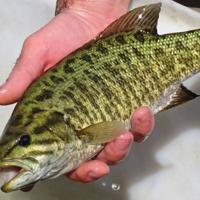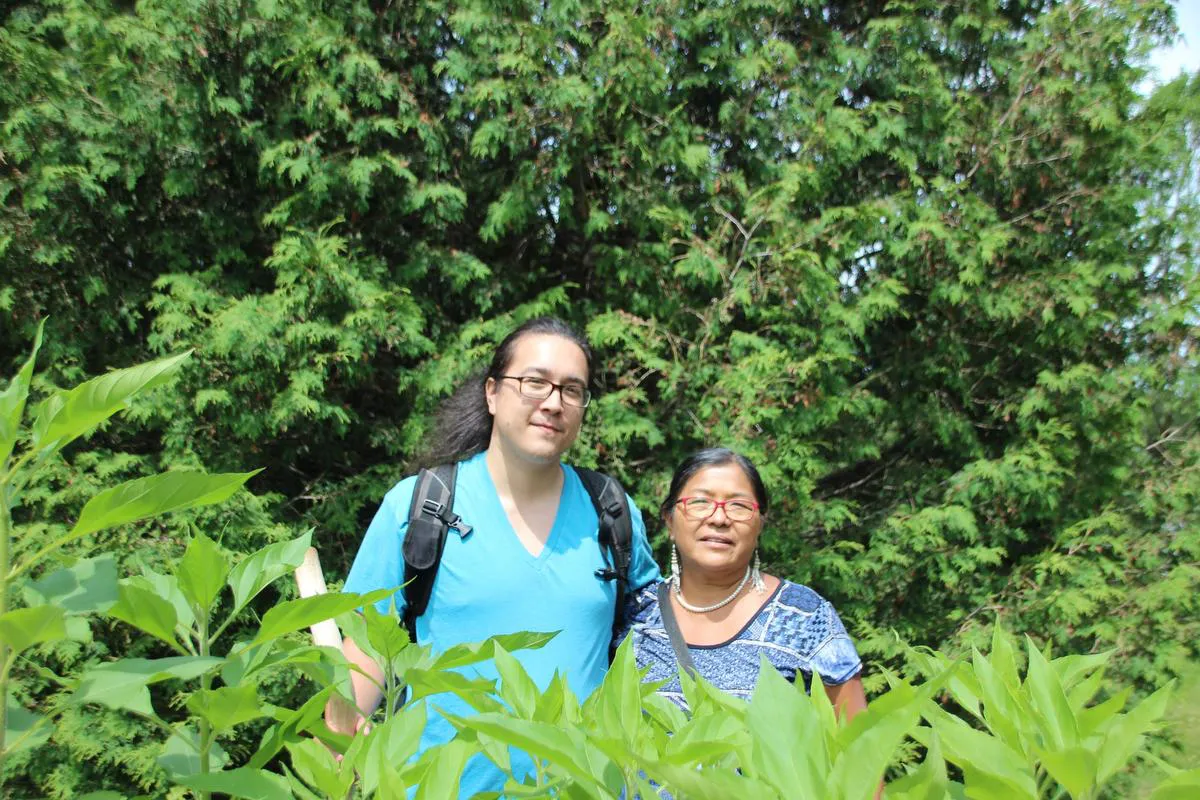In social media recordings of the unusual fishing experiences he’s had, none may generate the kind of attention as when Raef Smalley reeled in a smallmouth bass in the Gardner River on Feb. 19, just outside Yellowstone National Park.
“I was just in shock,” he said. “I had never caught one in Montana.”
The pan-size bass, which he held up before the camera before releasing, is an invasive species. It’s not supposed to be near the Gardner River. With the location of the catch so close to Yellowstone’s border, park officials are now worried about yet another nonnative fish messing with the balance of the unique ecosystem.
“I highly doubt this fish was alone,” said Todd Koel, fisheries program lead biologist for Yellowstone National Park.
“It’s pretty concerning to us,” he added.
The Gardner River is a tributary to the Yellowstone River, entering the stream just below the Black Canyon of the Yellowstone in the community of Gardiner. The town is across the street from the northern border of the park and only a short wildlife-filled drive from park headquarters at nearby Mammoth Hot Springs, Wyo.
People are also reading…
“So this is pretty much in the headwaters, much farther upstream than smallmouth have gotten before,” said Eileen Ryce, Fisheries Bureau Chief for the Montana Department of Fish, Wildlife & Parks.
The discovery of an aquatic invader so close to the park – although not a complete surprise because the bass have been slowly moving up the Yellowstone River – is cause for worry.
“They’re a pretty awesome fish,” Koel said. “They’re just in the wrong spot.”
Invasives
The park has experienced similar problems before.
In 2019, a single cisco was netted in Yellowstone Lake. A study of the fish found it had been born in the lake. Park biologists have been searching to find more of the invasive nonnatives.
More famously, in 1994 lake trout were discovered in Yellowstone Lake, perhaps the last native stronghold for Yellowstone cutthroat trout. Since the predatory fishes’ discovery, cutthroat trout numbers have plunged as lake trout gobbled up the native fish.
The park has spent millions to net and remove lake trout each summer, as well as experimenting with ways to kill eggs at lake trout spawning grounds. The National Park Service estimates more than 3.4 million lake trout have been killed during the netting. As a result, populations of the nonnative fish age 6 and older have declined an estimated 71%.
The fish species in Yellowstone had been fairly stable for almost a century until the recent problems, Koel noted.
A park visitor takes a dip in the Boiling River hot springs at Yellowstone National Parkin this 2013 photo.
Falls, warmth
Luckily, the Gardner River’s Osprey Falls will keep smallmouth as well as other fish from moving very far up the small stream that’s born in the Gallatin Mountains. The Gardner River’s other significant feature, however, serves as an attractant. The section known as the Boiling River, a place where bathers soak as geothermally heated water pours off cliffs into the Gardner, raises the river’s water temperature.
Although smallmouth bass are a coldwater species, they don’t like water as cold as trout. Smallmouth thrive around 50 to 70 degrees, whereas trout like 40 to 60 degree water. This makes the heated waters of the Gardner River a bit more appealing to a wintering smallmouth bass, which could be the reason the fish was found nearby.
“It’s many degrees warmer than the mainstem Yellowstone,” Koel said. “That’s the predicament.”
Up the Yellowstone River, not far from where the Gardner River joins, is 15-foot tall Knowles Falls. The cascade’s small stature is a concern. Should some smallmouth be able to navigate this obstacle, the species would have access to the Lamar River and lower Slough Creek, as well as the Yellowstone River up to the Lower Falls in the scenic Grand Canyon of the Yellowstone. Yellowstone Lake is above the falls, so it will be safe from any bass migration upstream.
“There is a good chance that smallmouth in the Yellowstone River will eventually be able to pass over Knowles Falls in the Black Canyon,” Koel wrote in an email to his state fisheries counterparts. “If that happens we will one day see them at Tower, the Buffalo Ranch, and the Slough Creek campground.
“This will be the only nonnative fish species in the park capable of preying upon semi-aquatic animals such as snakes or fledgling waterbirds,” he added.
Parks officials have been working for years to rid Slough Creek of nonnative rainbow trout, installing a fish barrier near the campground. Anglers are required to keep and kill any rainbow or rainbow-cutthroat hybrid they catch in Slough Creek. At the head of the Lamar, multiple state and federal agencies cooperated to remove nonnative brook trout from Soda Butte Creek over several years. So elimination of nonnative species has generated a lot of attention from park officials over the years.
Low water years, thanks to drought, could make it easier for smallmouth to negotiate Knowles Falls, Koel said. “It may not be a barrier to smallmouth bass. They’re athletic.”

Smallmouth bass are not native anywhere in Montana, but were once planted in the Tongue and Bighorn rivers.
Water
Low water summers are also increasing temperatures in streams across the state as their levels drop to record-setting lows. The river gauge just downstream from Gardiner recorded its highest temperature ever this summer, 70 degrees, according to Scott Opitz, FWP fisheries biologist in Livingston. Near Livingston, the river warmed to 72 degrees.
“If they are in the Gardner this winter, and runoff is like last year, they might find a pretty good home for a while,” said Dan Vermillion, a Livingston fishing outfitter and former Montana Fish and Wildlife Commissioner.
On family land near Greycliff, just downstream of Big Timber on the Yellowstone River, Vermillion said he began catching smallmouth bass regularly around 2008, about 116 miles downstream from the Gardner River. After the high runoff year of 2010, the fish disappeared, he added. It may not be a coincidence that the last two low water years allowed the fish to migrate farther upstream, Vermillion speculated.
“They’re strong pioneers,” he said.

Smallmouth bass are a coolwater species, although they are adapted to waters warmer than what trout prefer.
Planters
Smallmouth bass have been on the radar of Montana Department of Fish, Wildlife & Parks fisheries biologists’ for some time. The species was first planted in the Tongue River in the 1960s and the Bighorn River in the 1980s and 90s. Both rivers are tributaries to the Yellowstone, but more than 300 miles downstream from where the Gardner River joins.
Slowly, FWP fisheries crews have documented smallmouth bass being caught or turning up in surveys farther and farther upriver. The most recent was an angler caught smallmouth in 2018 in the Paradise Valley near the town of Emigrant, according to Opitz.
The prevailing theory is that someone who likes to catch smallmouth bass is planting the fish, Ryce said. She called the illegal introduction of the fish Johnny Appleseed-type events.
Opitz said the fish may not be showing up when FWP does electro-shocking for fish counts because the department is geared toward trout. Catching more smallmouth in the sampling would be easier with different settings and altered equipment, he said.
Reservoir
In 2020, FWP discovered smallmouth bass in a reservoir in the Shields Valley. The reservoir was connected to the Shields River, another waterway FWP is working to preserve for the northernmost population of native Yellowstone cutthroat trout.
One good side effect to last year’s drought was that the reservoir dried up, eliminating any smallmouth.
“We’re pretty optimistic they got wiped out,” Ryce said.
Four of the reservoir fish of different sizes were tested, all had been born in the reservoir, Opitz said. What’s more, last summer an angler reportedly caught a smallmouth in the Shields River downstream from Cottonwood. Since improvements to the Chadbourne Diversion Dam on the Shields, Opitz is fairly confident the smallmouth came downstream and not up from the Yellowstone River.

The Gardner River, at middle right, joins the Yellowstone River just outside the community of Gardiner and not far from the Yellowstone National Park boundary. This shot looks up the Yellowstone River.
Plans
Talks between FWP and Yellowstone fisheries officials are planned. In the meantime, Yellowstone biologists will take water samples from the Gardner and upper Yellowstone to see if tests can detect bass DNA in the water. A strong signal may indicate lots of fish, but no detection does not mean there are no fish, Koel said.
Evidence of bass DNA could allow the park to electrofish sample and see if they can remove any pioneers. Or the information could be used to point anglers to the area.
Anglers may be the best resource the agencies have on their side. To that end, anyone on the upper Yellowstone River who catches a smallmouth bass is being asked to keep the fish and turn them over to the Montana Department of Fish, Wildlife & Parks. The same goes for Yellowstone Park anglers.
The fish can be tested to find out whether they are successfully reproducing in the river or were introduced.
Removing the fish is also the best way to keep nonnative bass from successfully reproducing and continuing to expand into new habitat.
“Overall, the Yellowstone could be fairly hospitable to smallmouth,” Ryce said. “It’s not super productive, so it’s hard to tell.”
The worst-case scenario Ryce sees is smallmouth staging at the confluence of smaller streams and gobbling up native fish fry swept or swimming downstream. It would take a lot of bass to cause significant damage, she added.
“The public is our best chance right now,” Ryce said.

The Gardner River in Yellowstone National Park may be a new smallmouth bass hot spot, thanks to its warmer winter temperatures due to geothermally heated springs that flow into the river. The park’s fisheries biologist had help from his son tracking down the angler who posted a video of his catch, Montana State University freshman Raef Smalley.
Fishing
Given the situation, guys like Montana State University freshman Raef Smalley can make a conservation difference. He was fishing just downstream of the Gardner River’s confluence with the Yellowstone River. On the second cast of his fly rod, spooled with weighted line, he hooked the now famous bass that was barely longer than the fly.
“My jaw just dropped,” he said, at first thinking it was an oddly colored brown trout.
“It gets fished hard there, too,” he added. “So it’s kind of surprising nobody has caught a smallie there.”
He’s been back twice, but couldn’t repeat his smallmouth catch, frustrated now that he knows he should have kept the fish. Fly shop workers wanted to see proof of his catch after he told them the story. It’s almost as crazy as his tale about a smallmouth bass hooking him in the eyelid, a lure that had to be surgically removed.
“Everyone is calling me the smallie catcher,” Smalley said and laughed. “My friends said, ‘If anyone was going to catch it, it would be you.’”
Credit: Source link































